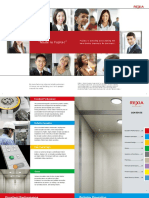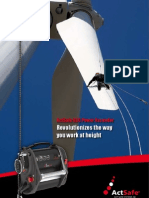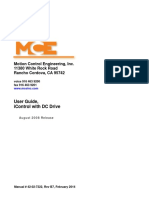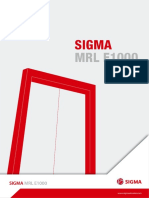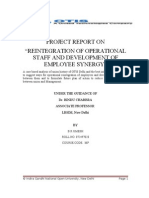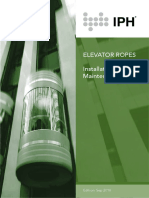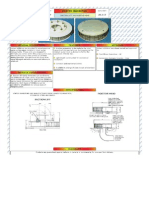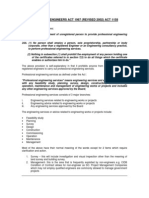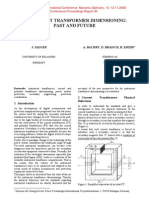Otis Regenerative Drives
Otis Regenerative Drives
Uploaded by
tan0314Copyright:
Available Formats
Otis Regenerative Drives
Otis Regenerative Drives
Uploaded by
tan0314Copyright
Available Formats
Share this document
Did you find this document useful?
Is this content inappropriate?
Copyright:
Available Formats
Otis Regenerative Drives
Otis Regenerative Drives
Uploaded by
tan0314Copyright:
Available Formats
Regenerative Drive Otis brings the advantages of regenerative drives to low and high-rise
Regenerative Drive
residential and commercial buildings. The compact modular design
The smart choice makes the regenerative drives ideal for application on Otis equipment
up to 15m/s.
BENEFITS FEATURES
Environmentally friendly Environmentally Friendly
Energy savings (up to 70%) Energy savings, lower harmonic distortion and smaller radio frequency interference that
meet or exceed the established world standards make regenerative drives the product
Lower Harmonic Distortion (typically below of choice for green building initiatives.
5%)
Energy Savings
Reduced Radio Frequency Interference
Significant cost savings In a typical non-regenerative drive, energy is dissipated as heat in a set of resistors
when braking occurs, resulting in reduced efficiency and creating additional waste-heat
Smaller main cables loads in the building. The regenerative drive feeds this energy back into the buildings
internal electrical utility where it can be used by other loads or users connected to the
Reduced power demands in peak periods same network.
Otis regenerative drive is so efficient that its power factor cos(PHI) is close to unity.
The result is a reduction in overall energy demands on the building by up to 70%.
Low Harmonic Distortion
Regenerative drives produce clean power with low distortion of the incoming
sinusoidal waveform line current. Total Harmonic Distortion (THD) at nominal load is
typically equal or below 5 per cent, versus more than 80 per cent for non-regenerative
drivesresulting in less pollution of the buildings electrical power system, thus helping
to protect sensitive building equipment.
Reduced Radio Frequency Interference (RFI)
Otis regenerative drives are designed to substantially minimise the RFI, also known
as Electromagnetic Interference (EMI), in compliance with strict legislations around the
World.
Significant Cost Savings
Two key factors influence the energy costs:
A fixed amount per year proportional to the subscribed peak power demand
expressed in kilovolt amperes (kVA)
A variable amount related to the energy consumption expressed in kilowatt-
hours (kWh)
With Otis regenerative drives, both the peak power demand and the energy
consumption are substantially reduced.
The overall effect is significant savings to the building owner and tenants, year-after-
year during the life of the elevator.
Energy saving with a regenerative drive in relation to the number of floors
and percentage of load. Maximum energy saving of 70 per cent can be
achieved when the car load is zero or 100 per cent.
Regenerative Drive Electrical power is generated when the elevator travels up
with a light load, travels down with a heavy load and during
Optimal System Performance
The combination of regenerative drive control with Permanent Magnet
the elevator systems deceleration. In effect, a fully loaded, Synchronous Motors (PMSM) permits the optimisation of motor and drive
descending elevator can now provide a significant portion of voltages resulting in a reduction of currents during regular usage.
the power for an adjacent ascending elevator.
Brown-out tolerant
The amount of energy savings due to regeneration depends
The drive will continue to operate with acceptable levels of degradation
on various system parameters and configurations such as duty
(reduction of contact speed and acceleration rates) in the event of a drop in
load, speed, length of run, traffic pattern and system efficiency.
voltages up to 30% below standard.
Modelling and simulation results show that Otis regenerative
drives use up to 70 per cent less energy than non-regenerative Superior ride quality
drives for equivalent elevator motion; that is, the energy State-of-the-art, 32-bit high-speed digital signal process and new control
consumed by the propulsion system to move the loads. algorithms for profile generation and position accuracy result in a smoother
As a green cost-effective option for the Gen2 system, Otis ride and improved floor-to-floor time to move more people in less time.
regenerative drives are the smart choice for your next low or
mid-rise installation.
SPECIFICATIONS
Otis regenerative drives can be used with geared or gearless
systems (up to 15 m/s) and is best suited for application on
Gen2 systems.
Typical duty specification
Gen2 systems with loads from 1150kg to 1600kg and
speeds from 1.0 m/s to 2.5 m/s are ideally suited to an Otis
regenerative drive.
Profile: 20-floor building, 60 metre rise, 300,000 trips per year.
Gen2 system Gen2 system Geared system
Regenerative Drive Non-Regenerative Non-Regenerative
Gearless PRSM motor Drive Drive
Duty Gearless PMSM motor Induction Motor (IM)
Energy Cost (*) Energy Cost (*) Energy Cost (*)
[kWh] [kWh] [kWh]
1275 kg 3261 $ 326 8721.7 $ 872 12845 $ 1285
1.6 m/s
1600 kg 4086.9 $ 409 10929 $ 1093 16137 $ 1614
1.6 m/s
(*) Cost of energy assumes $0.10/kWh
31-445-014 (07-07)
Australia (Head Office) New Zealand (Head Office) Customer Service and Support
Unit 1-3, 5-9 Ricketty Street Level 4, 60 Stanley Street Australia 1800 622 101
Mascot NSW 2020 Parnell New Zealand 0800 655 438
Australia New Zealand
tel: 61 2 8338 2700 tel: 64 9355 6600 www.otis.com
fax: 61 2 8337 6788 fax: 64 9355 6696 otis.marketing@otis.com
Copyright Otis Elevator Company. All rights reserved. The information contained herein is the
property of Otis Elevator Company and no part may be reproduced, used or disclosed except as
authorised under contract or by prior written permission.
You might also like
- UT CH 301 UNIT 1 EXAM-SolutionsDocument7 pagesUT CH 301 UNIT 1 EXAM-SolutionsbrunosipodNo ratings yet
- Pascal LawDocument4 pagesPascal LawpratishgnairNo ratings yet
- Gen2 ComfortDocument10 pagesGen2 ComfortRethish KochukavilakathNo ratings yet
- Fujitec Is Creating and Leading The New Global Standard For ElevatorsDocument20 pagesFujitec Is Creating and Leading The New Global Standard For ElevatorsMartin PortilloNo ratings yet
- Kone-The Monospace Launch in GermanyDocument11 pagesKone-The Monospace Launch in GermanyAakanksha Gulabdhar MishraNo ratings yet
- SEIA Lab ManualDocument59 pagesSEIA Lab ManualPradyumn SharmaNo ratings yet
- MPDS Codes PDFDocument19 pagesMPDS Codes PDFjared999No ratings yet
- TMdrive MVe2 SeriesDocument9 pagesTMdrive MVe2 SeriesDramebaaz SandeepNo ratings yet
- Practical Guide SequelecDocument24 pagesPractical Guide SequelecDevi PrasadNo ratings yet
- Gen2 Stream Brochure EN PDFDocument15 pagesGen2 Stream Brochure EN PDFyounesNo ratings yet
- LiftDocument43 pagesLiftalyajimmy11No ratings yet
- DrakaTechTipNo.1 CompensatingChain PDFDocument2 pagesDrakaTechTipNo.1 CompensatingChain PDFKar Keong LewNo ratings yet
- OPTIMA. Can A Quality Lift Ever Have Been So Cost-Effectively Designed?Document10 pagesOPTIMA. Can A Quality Lift Ever Have Been So Cost-Effectively Designed?Nezzlupiba LoveNo ratings yet
- Vision InstallationDocument14 pagesVision InstallationОлег ЛеонтьевNo ratings yet
- New Lift Standards PDFDocument10 pagesNew Lift Standards PDFMichael LagundinoNo ratings yet
- Accii LR2Document4 pagesAccii LR2pnsanatNo ratings yet
- Elevator Shaft VentilationDocument2 pagesElevator Shaft VentilationRachel Dollison100% (2)
- Flow 2 Stairlift Brochure PDFDocument8 pagesFlow 2 Stairlift Brochure PDFJustin ThomasNo ratings yet
- User Guide: Tracer™ TD7 With UC 800Document24 pagesUser Guide: Tracer™ TD7 With UC 800Modussar IlyasNo ratings yet
- Tricon 42-02-2T00 F4Document301 pagesTricon 42-02-2T00 F4ElputoAmo XD0% (1)
- Motion 2000 Hydraulic V9 42-02-1P21 A9Document294 pagesMotion 2000 Hydraulic V9 42-02-1P21 A9ElputoAmo XDNo ratings yet
- Manuel Minivator 2000Document46 pagesManuel Minivator 2000TUPET81100% (1)
- Icontrol DC Aug 08 Rel 42-02-7222 B7Document788 pagesIcontrol DC Aug 08 Rel 42-02-7222 B7ElputoAmo XDNo ratings yet
- Ttu SVN02L enDocument56 pagesTtu SVN02L enOscar Zelaya0% (1)
- Sigma MRL E1000 PDFDocument8 pagesSigma MRL E1000 PDFMitroNo ratings yet
- Gen2 Flex 26l PDFDocument16 pagesGen2 Flex 26l PDFGustavo Castillo100% (1)
- PM 7 000160 en 01Document26 pagesPM 7 000160 en 01mal.mellowsNo ratings yet
- Nauka Energo Tech EngDocument2 pagesNauka Energo Tech Engengfayad2No ratings yet
- Advance Services PDFDocument359 pagesAdvance Services PDFImtiyaz MohammadNo ratings yet
- K10616 V01 35 00 English 111208 HK PDFDocument81 pagesK10616 V01 35 00 English 111208 HK PDFTroubleshootingNo ratings yet
- FR A 500 ManualDocument242 pagesFR A 500 ManualkothuwonNo ratings yet
- LiftDocument8 pagesLiftpooja modia100% (1)
- Otis, Elisha Graves REPORTDocument7 pagesOtis, Elisha Graves REPORTrmcclary76No ratings yet
- Motion 2000 Hydraulic v8 42-02-1P20 B7Document248 pagesMotion 2000 Hydraulic v8 42-02-1P20 B7ElputoAmo XD100% (1)
- Datasheet Aritco 4000 enDocument2 pagesDatasheet Aritco 4000 enBuzaare100% (1)
- Owner's Guide: ExcelevatorDocument16 pagesOwner's Guide: ExcelevatorfreddyjoertyNo ratings yet
- Ving Card Slim Line EncoderDocument2 pagesVing Card Slim Line EncoderEsteven D. FulgarNo ratings yet
- Tracer Summit: Building Automation SystemDocument24 pagesTracer Summit: Building Automation SystemBahaa bunniNo ratings yet
- 2024 SEC Co. Philippines, Inc. Corporate ProfileDocument16 pages2024 SEC Co. Philippines, Inc. Corporate ProfileKevin GaganteNo ratings yet
- Scope of Lift InspectionDocument1 pageScope of Lift InspectionPABNo ratings yet
- ASG-01.01.002 - Main - En.g.1 Maintainance and Operation ManualDocument42 pagesASG-01.01.002 - Main - En.g.1 Maintainance and Operation ManualAhmed RaafatNo ratings yet
- SURAPID Elevator Company Profile PDFDocument34 pagesSURAPID Elevator Company Profile PDFLe Huynh LongNo ratings yet
- Trouble Shooting Procedures Uc1, Uc1A, Uc2, Uc2A: CautionDocument6 pagesTrouble Shooting Procedures Uc1, Uc1A, Uc2, Uc2A: CautionJeffrey NewmanNo ratings yet
- ElevatorsDocument11 pagesElevatorsDalia M-aNo ratings yet
- Spec ElevatorsDocument7 pagesSpec ElevatorsDolyNo ratings yet
- FP-07 - All Home Cdo - 070317 PDFDocument1 pageFP-07 - All Home Cdo - 070317 PDFLowentan LaxamanaNo ratings yet
- Lift Brake DesignDocument67 pagesLift Brake DesignmattNo ratings yet
- Kone Manual InstalareDocument15 pagesKone Manual InstalareAndreea DanielaNo ratings yet
- Project Union Final Otis 2Document70 pagesProject Union Final Otis 2pavnijainNo ratings yet
- Otis Fact Sheet Milestones 2011Document6 pagesOtis Fact Sheet Milestones 2011Siti Salwani binti Ab RahimNo ratings yet
- Elevator Traction Machine 20131018 Elevator Traction MachineDocument8 pagesElevator Traction Machine 20131018 Elevator Traction MachineTh Nattapong100% (1)
- Elevator Test Method Rev. 1 (Dood)Document12 pagesElevator Test Method Rev. 1 (Dood)Akhil100% (2)
- Elevator Ropes IPHDocument8 pagesElevator Ropes IPHAbhishek Saha100% (1)
- CPLDocument108 pagesCPLEduardo LegorretaNo ratings yet
- Acceptance Checklist: Elevator Machine Room And/or Control SpaceDocument4 pagesAcceptance Checklist: Elevator Machine Room And/or Control SpaceImran KhanNo ratings yet
- Cibes Catalogue PDFDocument31 pagesCibes Catalogue PDFNold Alburo100% (1)
- Light Curtain Guide For ElevatorsDocument10 pagesLight Curtain Guide For ElevatorsFERNSNo ratings yet
- Traction Drive Elevator Without Machine Room With Variable Car Dimensions. Rated Load 630 - 1050 KGDocument8 pagesTraction Drive Elevator Without Machine Room With Variable Car Dimensions. Rated Load 630 - 1050 KGTúlio ParreirasNo ratings yet
- Product GuideDocument13 pagesProduct Guidemaria paulaNo ratings yet
- Regen Drive UK PDFDocument2 pagesRegen Drive UK PDFAliRouyouNo ratings yet
- EcopxDocument6 pagesEcopxWahib GaranbaNo ratings yet
- Absorption Chiller IntroductionDocument34 pagesAbsorption Chiller Introductiontan0314100% (1)
- SDC IEM Talk - CKDocument56 pagesSDC IEM Talk - CKtan0314No ratings yet
- HVAC Advice From MuseumsDocument7 pagesHVAC Advice From Museumstan0314No ratings yet
- Museums & Libraries Archival StorageDocument2 pagesMuseums & Libraries Archival Storagetan0314No ratings yet
- Muziem & Library HVAC-1Document1 pageMuziem & Library HVAC-1tan0314No ratings yet
- Mictron Semi-Fire Alarm 900Document23 pagesMictron Semi-Fire Alarm 900tan03140% (1)
- York AHU Elect HeaterDocument1 pageYork AHU Elect Heatertan0314No ratings yet
- Control Valve Handbook-Part 2Document70 pagesControl Valve Handbook-Part 2tan0314No ratings yet
- FCU Engineering GuideDocument16 pagesFCU Engineering Guidetan0314100% (1)
- Transportation System in Building 2007Document54 pagesTransportation System in Building 2007tan0314100% (2)
- Vortex Inhibitor As117Document4 pagesVortex Inhibitor As117tan0314No ratings yet
- Rea 1967Document1 pageRea 1967tan0314No ratings yet
- Properties of Air SiDocument4 pagesProperties of Air Siiklln6No ratings yet
- Solar Apparent Time and Mean Solar TimeDocument2 pagesSolar Apparent Time and Mean Solar TimeavisanNo ratings yet
- Physics Project Class Xii 2021 22 Investigatory Project CompressDocument14 pagesPhysics Project Class Xii 2021 22 Investigatory Project Compresskingpratap.2024No ratings yet
- 8.3 Constraint Forces: Inclined PlaneDocument8 pages8.3 Constraint Forces: Inclined PlaneV Sree Suswara SuswaraNo ratings yet
- Trox TVSDocument12 pagesTrox TVSBiagio TROXNo ratings yet
- JD250Document2 pagesJD250Shahzad Ali100% (1)
- Magnetism and Matter Class 12 Notes Chapter 5 - Learn CBSEDocument8 pagesMagnetism and Matter Class 12 Notes Chapter 5 - Learn CBSESJquepNo ratings yet
- B Magnetism Power PointDocument73 pagesB Magnetism Power Pointsanthu37No ratings yet
- Expt - 1 - Verification of Superposition Theorem For Ac CircuitsDocument3 pagesExpt - 1 - Verification of Superposition Theorem For Ac CircuitsChaitanya Vivek DeshpandeNo ratings yet
- Leb30303-Electro Technique 2Document7 pagesLeb30303-Electro Technique 2Alif AkmalNo ratings yet
- Assignment (13th) WADocument11 pagesAssignment (13th) WARaju SinghNo ratings yet
- Schottky & Ohmic ContactsDocument33 pagesSchottky & Ohmic ContactsArchana TripathiNo ratings yet
- Design of Smoke Control System For Elev. Fire Evacuation Including Wind EffectDocument19 pagesDesign of Smoke Control System For Elev. Fire Evacuation Including Wind Effectefmartin21No ratings yet
- Manual de Instalação de Painéis UlicaDocument18 pagesManual de Instalação de Painéis UlicaRenilton Gomes DamascenoNo ratings yet
- Inst Transformer DimensioningDocument8 pagesInst Transformer DimensioningDeepen SharmaNo ratings yet
- Solving Problems Involving Variation: Quarter 2 - MELC 3Document16 pagesSolving Problems Involving Variation: Quarter 2 - MELC 3Norlie LamisNo ratings yet
- Pagdagdagan Chapter 15-16Document22 pagesPagdagdagan Chapter 15-16Reinzo Gallego100% (1)
- Half Wave RectifiersDocument7 pagesHalf Wave RectifiersVed PrakashNo ratings yet
- Power Transistor Driving Base Amplifier Built-In Type OptocouplerDocument8 pagesPower Transistor Driving Base Amplifier Built-In Type OptocouplerJavier Montañez VillamizarNo ratings yet
- Model Question Paper-1 With Effect From 2020-21 (CBCS Scheme)Document6 pagesModel Question Paper-1 With Effect From 2020-21 (CBCS Scheme)Preetham PreethuNo ratings yet
- Electrical Measurements Unit 1 Measuring InstrumentsDocument75 pagesElectrical Measurements Unit 1 Measuring InstrumentsnareshNo ratings yet
- TED (21) 2031 QPDocument3 pagesTED (21) 2031 QPSreekanth KuNo ratings yet
- TLE MajorDocument74 pagesTLE MajorNichaela Jane TerribleNo ratings yet
- Hydraulics Chapter 3Document9 pagesHydraulics Chapter 3tekalign yerangoNo ratings yet
- Lect 2 MeasurementsDocument73 pagesLect 2 MeasurementsRogerine RoyNo ratings yet
- 330-350W / 72 Cells / 5 Bus Bars Polycrystalline Module: GreenDocument2 pages330-350W / 72 Cells / 5 Bus Bars Polycrystalline Module: GreenCARLOS JAVIER COTRINA SAAVEDRANo ratings yet




